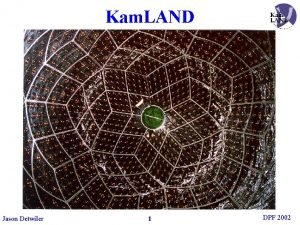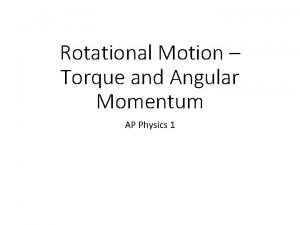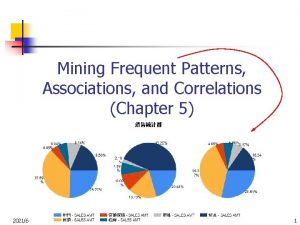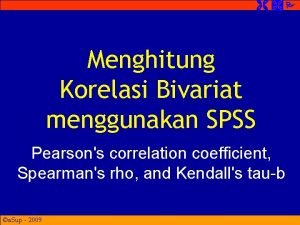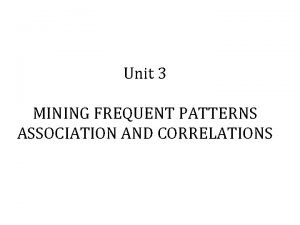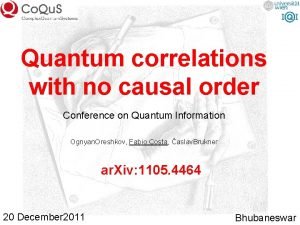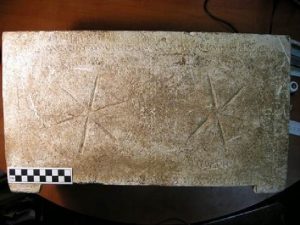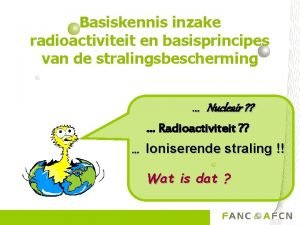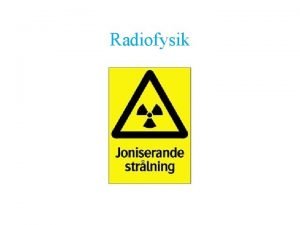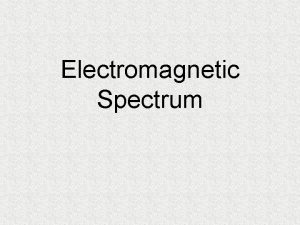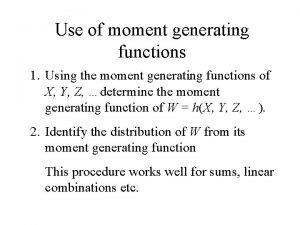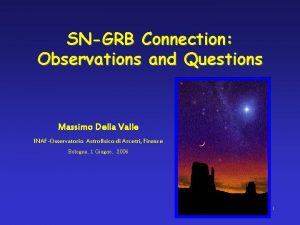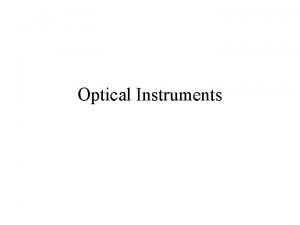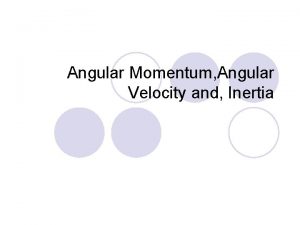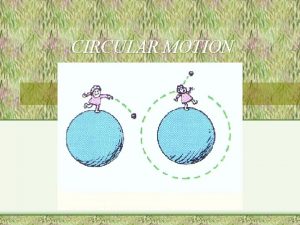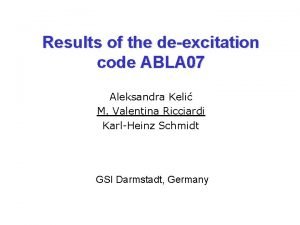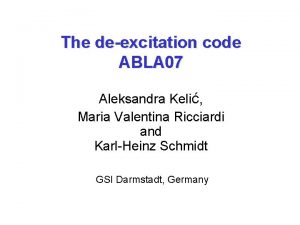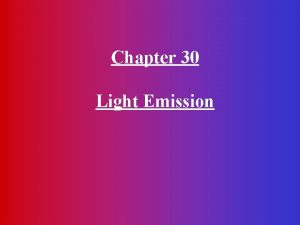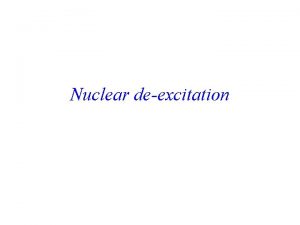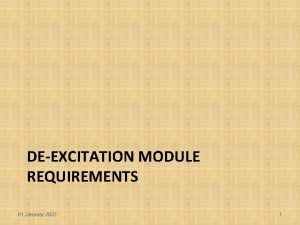Angular Correlations in Gamma Deexcitation Jason Detwiler Micah





































- Slides: 37

Angular Correlations in Gamma De-excitation Jason Detwiler, Micah Buuck, Ian Guinn, Aobo Li University of Washington March 3, 2015

Motivation: 60 Co Decay • An important source of background in my experiment (MAJORANA neutrinoless double beta decay search) • Background rate depends on both gammas hitting one detector: angle between the gammas matter • Well-known angular dependence, used for thermometry (“nuclear orientation thermometry”)

• An important source of background in my experiment (MAJORANA neutrinoless double beta decay search) • Background rate depends on both gammas hitting one detector: angle between the gammas matter • Well-known angular dependence, used for thermometry (“nuclear orientation thermometry”) P(q=0) / P(q=p/2) Motivation: 60 Co Decay Phys. Rev. 101, 1381 (1956). gm. B/k. T

Motivation: 133 Ba • A common calibration source for radiation detectors • My experiment: spectral fit useful for determining dead layers, active volume • Gamma summing depends on angular correlations in the cascade

IT Multipole Expansion • Nucleus decays from level with J = J 1, parity p, to state with J = J 2, parity p’, via emission of a gamma with angular momentum L: • Nomenclature: L=1 L=2 L=3 L=4 L=… p’ = p E 1 M 2 E 3 M 4 … p’ = p M 1 E 2 M 3 E 4 …

IT Multipole Expansion • For a particular value of M 1, consider the transition: • In this transition, the amplitude for photon emission in direction k is Clebsch-Gordannery • To include all M 1, sum over the density matrix for Nuclear the nuclear polarization states and Data square to get the probability for emission in direction Sphericalk. Harmonics

IT Multipole Expansion • For a particular value of M 1, consider the transition: • In this transition, the amplitude for photon emission in direction k is • To include all M 1, sum over the density matrix for the nuclear polarization states and square to get the probability for emission in direction k

Sampling Gamma Emission • Relevant equations are given explicitly in Alder and Winther, Electromagnetic Excitation, Appendix G (1975). • Required nuclear data is the dominant L, and for some transitions, the next most-important L (L’) and the relative strength between it and the dominant L (d). Available from the same ENSDF files from which Photo. Evaporation is derived, Laurent has made a test version in the past that included these.

Sampling Gamma Emission Typical calculation for an excited nucleus with J=J 1 that is going to de-excite to levels with J = J 2, J 3, … down to the ground state: 1. Start unpolarized: the “statistical tensor” representing the entangled nuclear state is trivial (rank 1 and equal to 1). 2. Sample k based on J 1 p, J 2 p’ , and L (and sometimes also L’ and d). 3. Update the statistical tensor based on the sampled value of k: the statistical tensor now represents a non-trivial entanglement of M 2 states. 4. Repeat from step 2 for J 2 ➞ J 3, J 3 ➞ J 4, etc. until you reach the ground state.

G 4 Nuclear. Polarization • Encapsulates / manages statistical tensor representing the entangled nuclear spin state throughout a gamma cascade

G 4 Nuclear. Polarization • Encapsulates / manages statistical tensor representing the entangled nuclear spin state throughout a gamma cascade • I ignore gamma polarization, although it could be easily added later if there is a need. • Not specific / particular to gamma cascades! Could be used e. g. for beta decay as well (although I have not implemented it)

G 4 Nuclear. Polarization • As a nuclear property, I propose to add the nuclear polarization info to G 4 Fragment: • Would go in processes/hadronic/models/util

Transition Data • Loaded into G 4 Discrete. Gamma. Transition along with other transition data. Then provide access:

Gamma De-excitation • With the polarization object and the transition data, angular correlations can be (optionally) generated within G 4 VGamma. Deexcitation: : Generate. Gamma(): Current Code: will become…

Gamma De-excitation • With the polarization object and the transition data, angular correlations can be (optionally) generated within G 4 VGamma. Deexcitation: : Generate. Gamma():

Gamma De-excitation • With the polarization object and the transition data, angular correlations can be (optionally) generated within G 4 VGamma. Deexcitation: : Generate. Gamma(): Allow to turn off and on Settable by messenger

Gamma De-excitation • With the polarization object and the transition data, angular correlations can be (optionally) generated within G 4 VGamma. Deexcitation: : Generate. Gamma(): Need to set J 1 in nuc. Pol at the top of the cascade (I’m not confident on where to do this yet)

Additional Required Tools • Angular momentum coupling: need to compute Wigner 3 J, 6 J and 9 J symbols – G 4 Clebsch has 3 J but not the others – gsl has these but G 4 doesn’t useful things like gsl • Angular distributions: need to compute associated Legendre polynomials – neutron/particle_hp have Legendre polynomials but not associated Legendre polynomials – CLHEP seems to have at least most of what is needed but the paired-down version in G 4 does not include CLHEP’s Legendre polynomial code – gsl also has these… • Random number generation: need to sample from simple polynomial functions – Surprised not to find generic code for generating random numbers from a simple polynomial, not in G 4 or in CLHEP. Maybe I didn’t look hard enough.

G 4 Clebsch • Currently in processes/hadronic/models/im_r_matrix. I propose to move it to global. • My change log: • Changes are backwards-compatible

G 4 Clebsch Testing • Generate 3 lists of parameters and solutions for each Wigner symbol (3 J, 6 J, 9 J) – Exhaustively scan through all angular momenta up to J = 5 that satisfy selection rules – Generate random sets of parameters up to J = 10 that do not need to satisfy selection rules • Comparison to gsl: – Found bug in gsl: https: //savannah. gnu. org/bugs/? 29606 • Comparison to Mathematica: – For 9 -j symbol, used angular. m notebook by Andrei Derevianko (University of Nevada, Reno) – Agreed to within a few parts in 10 -12 for all values tests, and to within machine precision for all cases of physical relevance (lower J)

G 4 Legendre. Polynomial • Propose to put this in global.

G 4 Legendre. Polynomial Testing 1. Generate Associated Legendre Polynomials with Mathematica through l=30 – Coefficients – Evaluations at random x-values 2. Compare to results from G 4 Legendre. Polynomial – Coefficients and evaluations agree to within machine precision

G 4 Polynomial. PDF

G 4 Polynomial. PDF • I propose to put this in global

G 4 Polynomial. PDF Testing 1. Randomly generate 100 polynomials with Mathematica 10 – Endpoints generated with Tan[Random. Real[{-Pi/2, Pi/2}]] – Random # of coefficients between 1 and 30 generated in same fashion – Only accept polynomials that are nonnegative between endpoints • Need well-defined PDFs – Normalize polynomials

G 4 Polynomial. PDF Testing 2. Generate 10000 random x-values for each polynomial and evaluate each polynomial at all 10000 points 3. Convert each polynomial to PDF and randomly sample 10000 times 4. Save polynomials, evaluations, random x-values, and random samples to disk 5. For each polynomial, compute max relative error of normalizing coefficients with G 4 Polynomial. PDF. Normalize() compared to normalizing with Mathematica – We achieve agreement to machine precision

G 4 Polynomial. PDF Testing 6. For each polynomial, evaluate at 10000 random x-values with G 4 Polynomial. PDF. Evaluate() and find max error relative to Mathematica – We achieve agreement to within machine precision 7. Randomly sample each polynomial 10000 times with G 4 Polynomial. PDF. Random. X() 8. For each PDF, compare random sampling to Mathematica with ROOT Kolmogorov. Test

G 4 Polynomial. PDF Testing KS test comparing above data to uniform distribution gives p-value of 0. 73

G 4 Nuclear. Polarization Testing • Rough test: checked that it generates correct polynomials for simple cases • Deep low-level test: check that it generates correct PDFs for multi-level cascades with high J 1 / J 2 / L (highly non-trivial entangled polarization state) • High-level test: generate 60 Co decay and “measure” the angular distribution produced by G 4

G 4 Nuclear. Polarization Low-Level Testing • Generate spherical distributions for three successive gammas emitted by nucleus – First gamma establishes polar axis – Second gamma establishes azimuthal axis – Distribution of angle between first and third gamma can be calculated by integrating out second gamma

G 4 Nuclear. Polarization Low-Level Testing 1. Code analytical expression for polarization tensor in Mathematica – From Alder and Winther 2. Compare theoretical prediction to Falkoff, Phys Rev 82, 98 (1951). – Good agreement, so Mathematica expression seems coded correctly • Integrated squared error of 1. 6 E-7 (over 4π solid angle)

G 4 Nuclear. Polarization Low-Level Testing 3. Compute polarization tensor in Mathematica for gamma triple cascade – Calculate distribution of angle between 1 st and 3 rd gamma. – Generate 1000 angle distributions with 1000 samples in each distribution 4. Use G 4 Nuclear. Polarization to generate 1000 gammas from this transition 1000 times – Compute 1000 KS statistics between G 4 and Mathematica generated distributions

Looks Good, Right? Randomly generated G 4 distribution (blue) overlaid with theoretical prediction (purple)

Problem! KS test comparing above data to uniform distribution gives p-value of 3. 5 E-7

Cause? • Not enough terms in ROOT KS distribution? – Doubtful, includes 3 terms which is good to machine precision. • Random numbers not random? – Maybe, Mathematica uses an extended cellular automaton generator, G 4 uses Mersenne Twister • Fun fact, Stephen Wolfram did research on cellular automata… • Round-off error in code? – Would have to be a small numerical effect – Could be in G 4 or Mathematica. Will compare each to a theoretical prediction

G 4 Nuclear. Polarization High-Level Testing • Use G 4 RDM to generate nuclear decay at the center of a spherical vacuum. • Tag gamma positions as they exit the sphere • Histogram angular correlations and compare to theoretical expectations • Setup is up-and-running, verified that G 4 indeed generates isotropic gammas • Need to finish implementation and obtain custom Photo. Evaporation data files to proceed

Status / To-Do • G 4 Clebsch, G 4 Legendre. Polynomial, and G 4 Polynomial. PDF are tested and ready-to-go • Will try to track down subtle numeric issue in G 4 Nuclear. Polarization. But it is already good enough for most applications I can imagine. • Need an updated custom version of Photo. Evaporation 3. 1 with the multipolarity and delta information. • Also need feedback / buy-in on proposed implementation, and info on meeting release schedule deadlines. • Will complete implementation in G 4. 10. 1 and test it with the highlevel tools. Will test at least with 60 Co and 133 Ba. Can complete in ~1 month once Photo. Evaporation data is in hand. • Will then profile / optimize code: expect angular correlation computations to be fast relative to geometry and other physics calculations. Red items are for your consideration at this workshop. I’m sorry I could not make it, I would really have liked to join.
 Jason detwiler
Jason detwiler Ward detwiler
Ward detwiler Jeffrey detwiler
Jeffrey detwiler Theorem of angular momentum
Theorem of angular momentum Mining frequent patterns associations and correlations
Mining frequent patterns associations and correlations Spurious correlations
Spurious correlations Bivariat
Bivariat Thinking critically
Thinking critically Associations and correlations in data mining
Associations and correlations in data mining Mining frequent patterns associations and correlations
Mining frequent patterns associations and correlations Quantum correlations with no causal order
Quantum correlations with no causal order Rowan county medicaid
Rowan county medicaid Micah 6:1-8 the message
Micah 6:1-8 the message Micah altman
Micah altman Micah dowty
Micah dowty Micah
Micah Micah 6 8 niv
Micah 6 8 niv Micah wissinger
Micah wissinger Micah beck utk
Micah beck utk Micah's idol
Micah's idol John 11 48
John 11 48 Micah 6:18
Micah 6:18 Micah laney
Micah laney Micah jendian
Micah jendian Micah fogel
Micah fogel Exodus 3 message bible
Exodus 3 message bible Micah williamson
Micah williamson Isaiah 46:3-9
Isaiah 46:3-9 But you bethlehem ephrathah
But you bethlehem ephrathah Micah 6 8 the message
Micah 6 8 the message Propiedades distribucion gamma
Propiedades distribucion gamma Gamma lettre
Gamma lettre Wegwerp overschoenen gamma
Wegwerp overschoenen gamma Litium emission
Litium emission Mnemonic for electromagnetic spectrum
Mnemonic for electromagnetic spectrum Uses of moment generating function
Uses of moment generating function Massimo della gamma
Massimo della gamma Mass of beta particle
Mass of beta particle
